Welcome to our free professional learning series on personal blogging! This series guides you step-by-step through the process of setting up your own personal or professional educator blog.
Refer our class and student blogging series if you want to set up a class blog.
The activities can be completed at your own pace and in any order.
Wherever you’re at — we’ll step you through the tasks designed to increase your skills while providing help to support your learning. Don’t stress, have fun, and remember to ask for help by leaving a comment any time you need assistance!
Optional workbook
Remember, we have a PDF workbook which you’re welcome to use to help keep you on track as you work through the course. Scroll down to find the ‘download’ button underneath the document.
📌 Download the PDF workbook here
The aim of this first activity is to:
- Help you learn more about what a blog is and why educators have their own personal or professional educator blog.
- Help you set up your blog, customize your settings, and change your theme.
What is a blog?
One of the biggest challenges educators new to blogging face is understanding the basics of how a blog works.
So we made this quick intro video to explain.
We recommend you start by watching the video. We’ve included explanations of key blogging vocabulary which will help as you work through this series including Footers, Headers, Menus, Pages, Posts, Comments, Sidebars, Theme, and Widgets.
Feel free to share this video on your own blogs with students, teachers, colleagues, or anyone else. Later in this series, we show you how easy it is to add videos to your blog.
Blogs? Websites? Portfolios?
Defining exactly “What is a blog?” is becoming harder to answer as the lines between blogs, websites, ePortfolios, and other online spaces blur.  A blog is simply a website, although traditionally a website will have been more of a static space. What makes a blog different than a simple website?
A blog is simply a website, although traditionally a website will have been more of a static space. What makes a blog different than a simple website?
- A blog traditionally would be updated fairly regularly and display posts in reverse chronological order.
- Comments have always been a key feature of blogs, providing an interactive space.
- Most blogs have pages where some key information is housed that isn’t updated very frequently (for example, an About Me page).
Nowadays, some people have a website that has a blog component; the home page doesn’t change but readers can click on a tab to view a regularly updated blog.
A blog is a blank canvas that you can use in any way to meet your needs!
Why educators use blogs
The main reasons why educators have personal/professional blogs include to:
- Share information and tips with other educators.
- Collaborate with a global audience. Increased collaboration with others leads to greater innovation and new perspectives.
- Reflect on their learning or their teaching/work practices.
- Learn how to blog themselves so they can use blogs effectively with their students.
- Create an ePortfolio.
- Document or remember professional development for their own use or accreditation.
Blogs are an important part of many educators’ PLN (Personal Learning Network).
Choosing your audience
Determining your audience is a useful first step when commencing any writing project.
Fortunately, when your writing is in the format of a blog, you have the flexibility to alter and adapt to different readers as your blog evolves.
The advantage of educational blogs is that the benefits come from the journey itself.
Despite this flexibility, it’s still advantageous to give your target audience some thought when starting a new blog.
Who will be reading your blog? Perhaps your audience will include:
- Local educators
- Global educators
- Student teachers
- Principals, administrators, and school leaders
- Parents (even if they’re not your target audience, they may read your work if you teach their child)
Stay open-minded as you embark on your blogging journey. Initially, you may choose your content for posts based on your perceived audience. As you get to know your audience more, and your own passions and interests develop, your content and writing style may evolve too. This is a natural pathway for many bloggers.
Refer to Who is Your Audience? Tips for Educators new to Blogging for more advice about choosing your audience. Back to Top
Examples of personal educator blogs
Your personal/professional blog extends your relationships outside of your school and allows you to connect with global educators who all willingly help each other.
Below are some examples of personal/professional educator blogs to see how they’re used.
This list is far from exhaustive! Be sure to tell us in a comment if you have any other favorite blogs by educators that aren’t on the list.
Click here to open this spreadsheet in a new window.
Sign up for your blog
Your first step if you don’t currently have your own blog, or you would like to use a new blog for this challenge, is to sign up for a blog.
You can use any blogging platform you would like including Edublogs, WordPress, and Blogger, however, when we write detailed instructions they will refer to Edublogs. You will be able to adapt this information to the blogging platform you are using.
Let’s go through some important things to consider before creating your blog.
1. Your Username
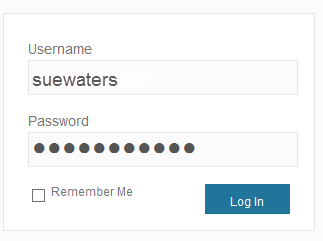 Your username is what you use to sign into your blog dashboard and is displayed on posts and comments you write.
Your username is what you use to sign into your blog dashboard and is displayed on posts and comments you write.
While you can’t change your username, most blog platforms do allow you to change how your name is displayed on posts and comments.
Most teachers don’t allow students to use their first and last name online and often model this by using display names like Miss W or Mrs. Waters on their class blog.
With personal blogs, teachers are more likely to use their first and last name because their primary goal is often to connect with other educators.
Using their full name helps others connect with them better on a personal level. For example, your username might be like suewaters with a display name like Sue Waters.
2. Blog URL (Domain)
During the creation of your blog you have to select a URL (blog address).
When you want others to visit your blog you share your blog URL. For example, the URL for the Teacher Challenge blog is https://teacherchallenge.edublogs.org/
Think carefully about your blog URL. This can’t be easily changed and once your blog has an established audience, you’re less likely to want to change your blog URL.
A simple option is to use your name in the blog URL or use something that has meaning.
Examples:
- Sue Waters Blog ( http://suewaters.com/ )
- Larry Ferlazzo’s Websites of the Day ( http://larryferlazzo.edublogs.org/)
- The Edublogger ( http://theedublogger.com/ )
- Free Technology for Teachers ( http://www.freetech4teachers.com/ )
3. Blog Title
Your blog title is one of the first things a reader sees when visiting your blog. Choose a name that reflects the purpose of your blog or you might simply use your name.
Don’t stress too much about your blog title! You can always change it at any time via Settings > General in your dashboard.
Check out the list of personal educator blogs for ideas of blog titles other educators have used.
4. Password
Passwords are our line of defense for protecting our online accounts. The stronger your password, the more protected your accounts are. You should always use strong passwords for all accounts and use strong passwords that are different for each of your important accounts.
While remembering multiple strong passwords can be annoying, at least all your other accounts are protected even if a password is compromised for one account.
New guidelines suggest that a passphrase can be stronger than a traditional password. Here’s how to create a passphrase:
- Come up with four or more words such as mysterious triangle bingo nurse
- Avoid using personal information or well known quotes or song lyrics (these can be easily guessed).
- Add some uppercase letters, symbols or numbers if you wish eg. #MYsteriousTr1angle=Bin.go.nur5e
- Avoid making the passphrase too complex when you add the punctuation and numbers. It’s important that you can still remember it.
You’ll find more tips for creating strong passwords, passphrases, and using password managers here.
Create your blog
Now you’ve done all the research it’s time to create your blog! All you need to do is follow these instructions if you would like to set up your blog on Edublogs.
Prefer a video guide? This 15 minute tutorial is a simple orientation to blogging.
Update your profile
Your Profile page is where you can control the global settings for your username including where you set up your display name, change your password, and alter your email address.
Your Profile is most commonly used to update display name, password, and email address so we’ll focus on this.
You’ll notice there are lots of personal settings options in Your Profile and you can read more about each personal setting here.
The most important thing to update is your display name. Setting up a display name makes it easier for some who leaves a comment to quickly look at your first name to personalize their comment.
If your username is displayed on posts means they have to search to see if they work out your first name.
Here’s how to update your Profile:
1. Log into your blog dashboard.
2. Go to Users > Your Profile in your blog dashboard. 
3. Scroll to near the bottom of the page to Nickname in the Name area.
4. Change the Nickname to the name you want to be displayed on posts and comments. 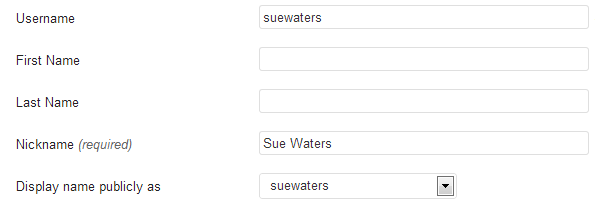
5. Click on the drop-down arrow and select your preferred publicly displayed name. 
6. Now, look at the email under Contact info. All comment notification and password reset emails are sent to this address. If you’ve set up your blog using our no email option it will look like this:

If you would like to receive comment notifications and be able to retrieve your password using the Lost Password link then we recommend you add your email address.
- Your email address is required. You may change this, but you can only use one e-mail address per username. This email address must be valid because to confirm that change an email will be sent to this address and it won’t be changed until you click on the link in the email.

7. Now scroll to the bottom of the page to the new password field. Change your password by clicking on Generate Password.
![]()
You can either use this automatically generated password or replace it with your own password.  There is no need to update your password (unless you want to). We just wanted to show you how it is done.
There is no need to update your password (unless you want to). We just wanted to show you how it is done.
8. Now just click on Update Profile to apply the changes.
Remember to always click on Update Profile whenever you make any changes on Your Profile page!
Upload your user avatar
Your avatar is an online representation of you. The user avatar is also known as your comment avatar.
You upload the user avatar via Users > Your Avatar and it displays in places where you leave comments and next to posts you publish on some themes.
The default avatar set in Settings > Discussions automatically displays next to comments you leave unless you upload your own Avatar.
Your user avatar helps your readers visualize who you are. It helps create a personal connection with your readers. Below is an example of a user avatar and display name next to a comment.

You upload your avatar as follows:
1. Select a photo. Most educators use a photo of themselves on their personal blogs.
2. Resize your image to 200 pixels wide by 200 pixels high.
3. Go to Users > Your Avatar.
![]()
4. Click on Browse and locate the avatar you want to upload.
5. Click on Upload. ![]()
6. Move the crop area to one corner, then expand the crop area to include your full image and click Crop image. ![]()
7. Now when you view a post where you’ve left a comment, you will see your new comment avatar. Important tips:
- If you change your avatar and still see the old avatar it may be your web browser remembering your old image.
- Hold the Ctrl key and press F5 to clear your browser cache.
Check your settings
The General Settings is where you configure the broad settings of your blog including your blog title, tagline, blog admin email address, and timezone.
The most important setting to update in General Settings is your timezone. Educators often assume that blogs are automatically created set to their timezone and weeks later wonder why the post and comments date and times are weird.
The other important thing to consider is the blog admin email address. This email address is where all comment moderation emails are sent. If you want to receive comment moderation emails you should add your email address.
You’ll find more information on the configurations options in General Settings here.
Here’s how to change your timezone:
1. Go to Settings > General. 
2. Select your timezone from the drop-down menu option.

3. Click Save Changes.
Customize your blog theme
Your theme is what controls the look and appearance of your blog; this is what people see when they visit your blog. This is how you give your blog its personal touch.
Like most things in life, first impressions count. Great blog themes make good impressions on readers so that visitors are more likely to check out your blog. Overwhelming themes detract from your blog content.
Every newly created blog normally has the same default theme. The last thing you want is to look like all the other blogs.
Customizing your blog theme is normally one of the first things most people want to do when they first log into their blog.
Tip: having a few posts on your blog may help you visualize your theme’s appearance better.
Let’s finish off getting your blog started by showing you how to customize your theme!
Using the theme customizer
With the theme customizer, you can customize your theme and see the results in real time before activating the theme.
Here’s how to change your theme using the theme customizer:
1. Go to Appearance > Themes

2. Click on ‘Live Preview‘ below the theme you want to use.
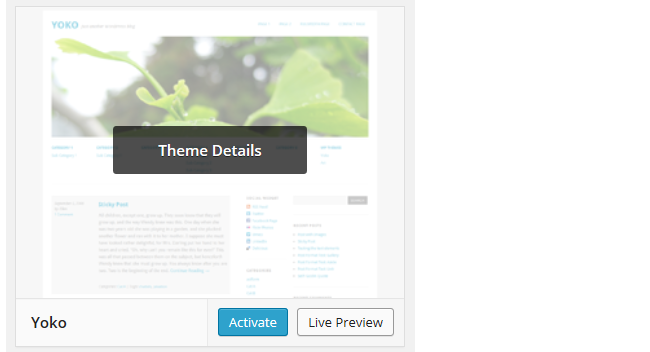
Or if you want to customize your current theme, click on ‘Customize‘ under the current theme.
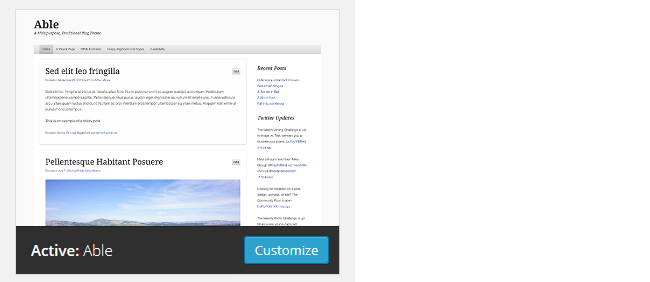
3. This loads the customizer. Now all you do is work through the control panels on the left to customize the theme. You can then preview the theme changes in real time before activating it on your blog.
4. Once you’re happy with the changes you just click ‘Save & Publish’.

Here’s a quick summary of each customizer control panel:
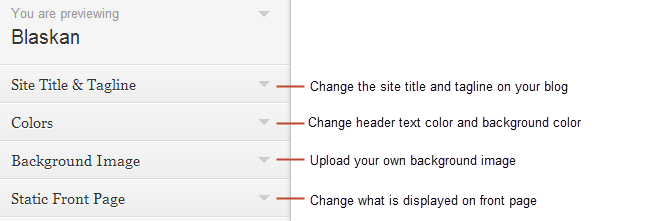
We recommend you leave the static front page set to ‘Latest Posts’. Most personal blogs use a blog post page for their homepage. You’ll find more detailed information on using the customizer here.
Almost all our themes include an option to upload your own custom image header. A custom image header means you can obtain a much more customized look and feel adding your “own personal touch” to your blog.
You upload your own custom header image as follows:
1. Click on Add new image in the header image section of the customizer. 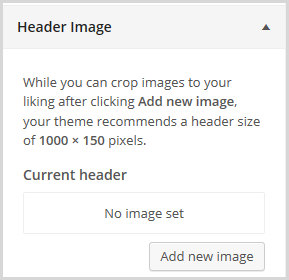
2. Choose an image from your media library or upload a new image from your computer.
- Only .jpeg, .gif, and .png files can be used for image headers.
- For best results, we recommend you re-size the image to the exact dimensions recommended for the theme before uploading using an image editing program.

3. Click on Select and Crop. 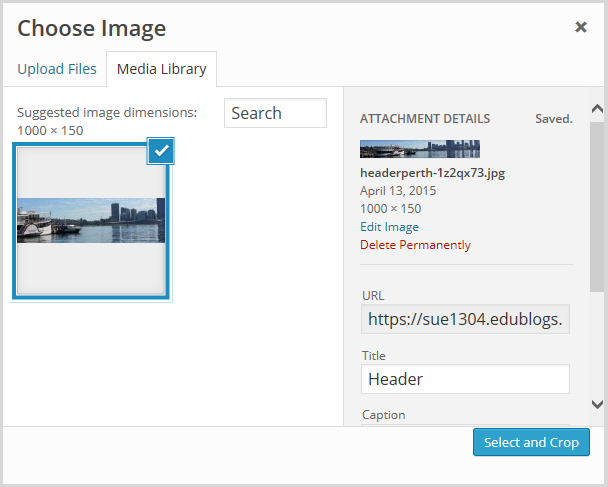
4. Click on Crop image. 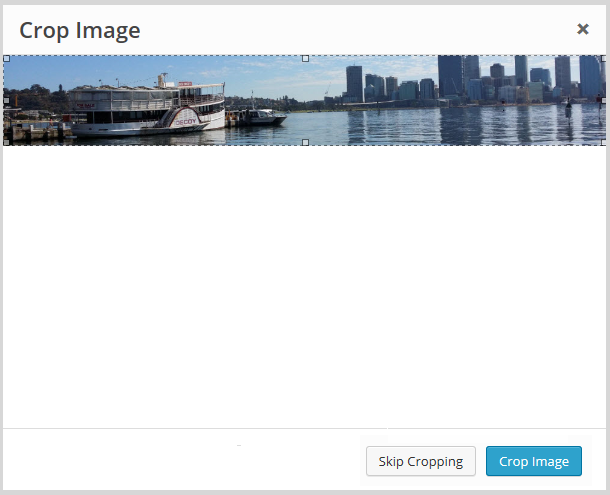
5. Your new header image should appear in your blog preview window.
6. Click Save & Publish on the Customizer to activate the new header on your blog.  Back to Top
Back to Top
Uploading your own background image
Most themes allow you to add images to your blog’s background.
A background image is another great way of adding that personal touch to your blog. You upload your own custom background image as follows: Click on Background Image in the Customizer.
- If you don’t see the Background Header section in the Customizer, it means the theme doesn’t support this option.
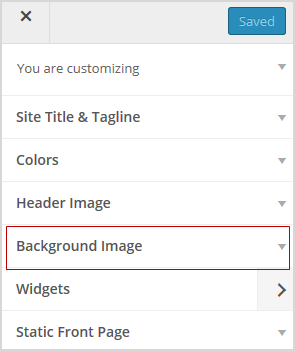
3. Click on Add new image.
4. Choose an image from your media library or upload a new image from your computer.
- Only .jpeg, .gif, and .png files can be used.
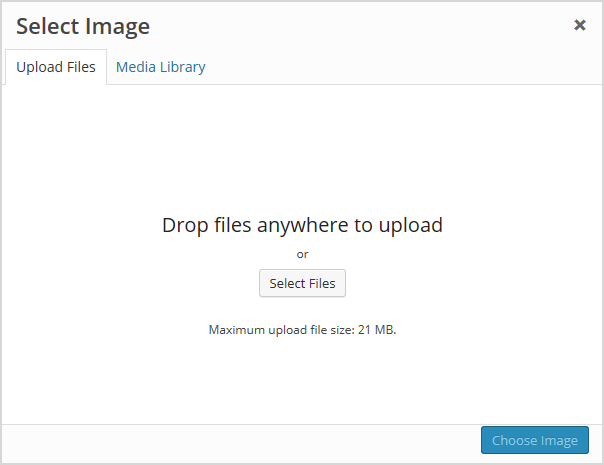
5. Click on Choose Image. 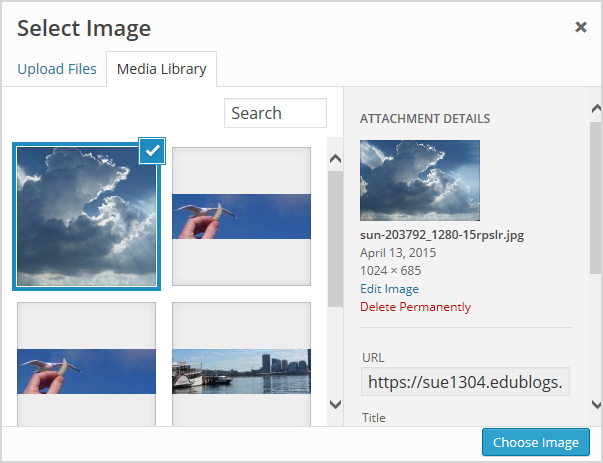
Once you have selected an image the background image options will appear:
- Background repeat: controls if the background image is repeated. Choices are:
- No Repeat — background image is only displayed once on the page.
- Tile — background image is tiled horizontally and vertically.
- Tile horizontally — background image only repeats horizontally.
- Tiled vertically — background image only repeats vertically.
- Background position: allows you to control the position of the background image. Options are left, center, and right.
- Background attachment: determines if you want the image to scroll with the content or to remain ‘fixed’ in place when a reader scrolls down the page.
For best results, we recommend you use Tile, left and Scroll.
6. Your new background image should appear in your blog preview window. \
7. Click Save & Publish on the Customizer to activate the new background on your blog. 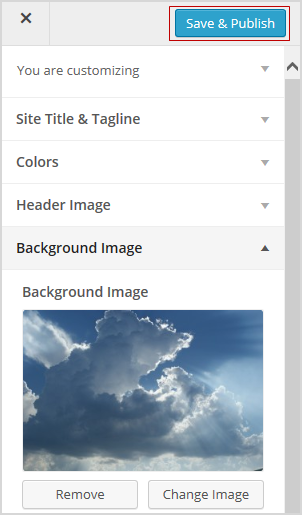
Commonly asked theme questions
Here are some answers to questions about themes we’re commonly asked.
1. Can I upload my own theme?
Because of the way blog platforms like Edublogs and Blogger work, you can only use the themes provided and can’t upload your own custom themes.
Remember that custom image headers and backgrounds are very effective ways of customizing your theme to meet your needs.
2. How do I change the font color, font size, and text color?
Some themes have extensive theme customization options which aren’t supported by the theme customizer.
They often include options to change font color, font size, and text color. These types of themes add a theme option menu item under Appearance once the theme is activated. To do more extensive customization, you go to Appearance > Theme Options.
You can also change font type, size, and color in posts or on pages using the Supreme Google Webfonts plugin. Back to Top
Your Task
Blogging is about sharing, collaborating, and learning from each other. Here’s your chance to ask a question, comment, and get involved!
We’d like you to add your voice and ideas to our ongoing conversation about blogging by undertaking one or more of the following tasks:
- Visit some of the blogs on the examples of personal educators blog list then leave a comment on this post to tell us which were your favorite blog(s) and why. Be sure to tell us if you have any other favorite blogs by educators that aren’t on the list.
- Leave a comment on this post and tell us how you went setting up your blog. For example, you could tell us what theme you chose and why? Or what you found easy? What aspects were hard and you would like to know more about?
- Leave a link to your blog in a comment on this post so we can have a look at your new blog.
How to leave a comment: Scroll down to find the comment box. Write your comment, then enter your name and email address (email addresses are not published). Enter the anti-spam word. Press submit and we will moderate your comment ASAP.
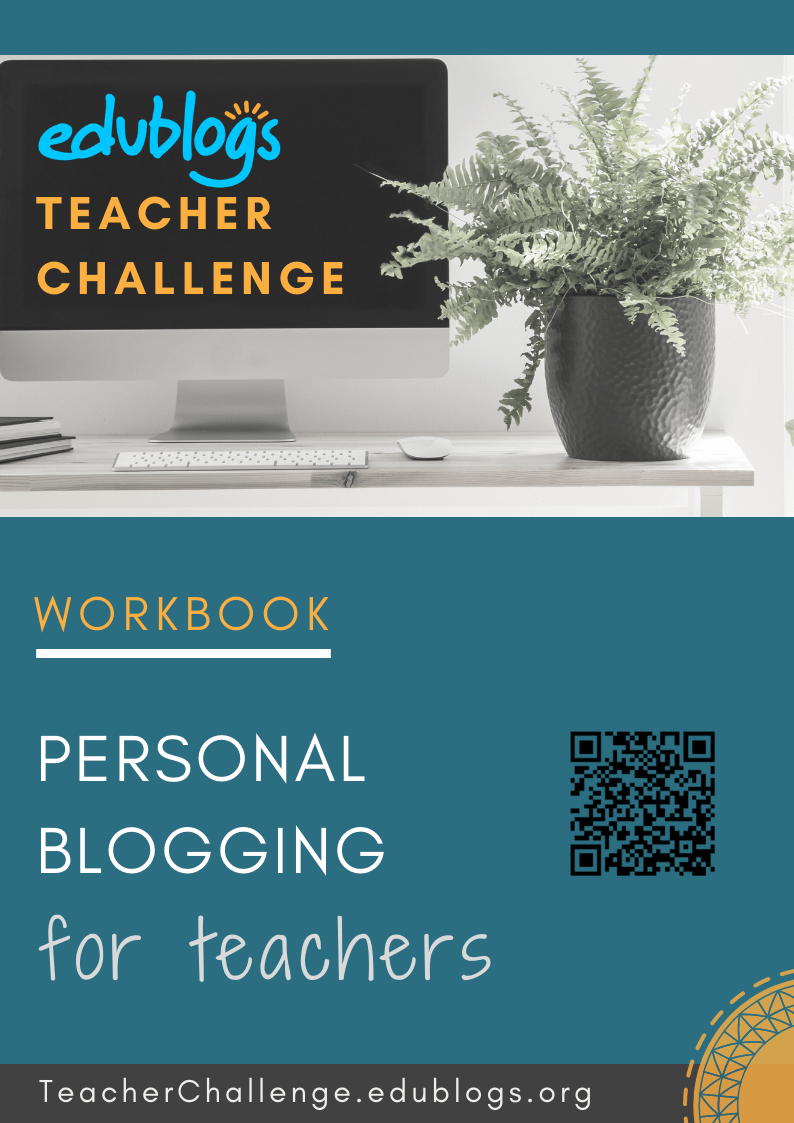

So I used Edublogs Responsive theme; the only free one available 🙂 My goal is to keep my blog simple and user friendly. I am not in the position to pay for the upgrade currently so I don’t know how can I make it a little bit more interesting and appealing. Anyway, here it is. http://aaishazclass.edublogs.org/
comments and suggestions appreciated .
Hi Aisha
Looks like you discovered there are several responsive themes that are free besides Edublogs Responsive as I can see you are now using the theme Able. Able is a great theme and you can upload your own header image which is one way of personalizing it more.
You look like you have got off to a great start! Well done. I like the yellow background.
Sue Waters
Support Manager
Edublogs | CampusPress
I’ve been using my edublog to keep students and families informed as to what is happening in our science classroom. I haven’t felt comfortable with how to set up the contact page, how to make it so that if someone were to google me my blog would come up, and how to get my students blogging using my edublog space.
Additionally, I recently changed the appearance of my blog in order to make it more user friendly for mobile devices. I liked my old site much better but it never worked on an iPad or iPhone in terms of being able to read it – the words would run into my background.
On to step two for more answers – I hope!
Thanks
http://sbharrison.edublogs.org/
Hi Shane,
In the second step of the teacher challenge, we discuss setting up contact pages: http://teacherchallenge.edublogs.org/step-2-set-up-page/
You have your blog correctly set under Settings > Reading for Google to index your blog. That being said, it’s up to Google’s algorithms to index your blog in its search results, and decide how high up in the rankings it displays.
Since you have Edublogs Pro, we recommend using My Class to set up student blogs: http://help.edublogs.org/my-class-overview/
We do have a large selection of themes that work on mobile devices – if you’re not satisfied with the one you’re currently using, you can go to Appearance > Themes and select “Mobile Friendly.”
If you need any help, drop us a line at support@edublogs.org!
Dan Leeman, Edublogs Support
I am looking forward to learning more during this challenge to make my personal blog even better http://kmwscienceguy.edublogs.org/ I want to learn as much as I can before introducing a classroom blog to my students.
Looks like a great start! I really resonated with “looking over your quiet classroom at that final moment…” right before all of the awesome chaos of students sets in 🙂
Let us know if you need any help getting set up before starting a classroom blog as well; happy to help at support@edublogs.org
Dan Leeman, Edublogs Support
Hello bloggers! I am following the steps written in the Edublog Teacher Challenge email. So one step at a time. I have never blogged before. Ever! I did, however, made some feeble attempts here and there, but nothing productive so far. Hundreds of successful educators already blogging intimidate me. This time around I’ve resolved to take the challenge! My favorite blog is the simple, neat and inspirational blog http://georgecouros.ca/blog/ by George Couros. I like the fact that he kept his blog so simple and easy to follow.
Hi Aisha,
Don’t think about it as intimidating; the hundreds of successful educator bloggers are all teachers who are passionate about what they do and want to share it with the world 🙂 We all have had to start somewhere, whether it’s writing a comment on a blog, or setting up our first posts.
I’m glad you’ve resolved to start blogging. Once you start getting content out there, it becomes easier to make other decisions. The great part is, it’s so easy to change something later on. Want to change a theme? Click a button. Want a different widget? Click a button.
And as always, if you need any help, don’t hesitate to email us at support@edublogs.org
Dan Leeman, Edublogs Support
I am interested in learning more about great education blogs out there and connecting with like minded educators.
I already have a blog http://hotlunchtray.com a self-hosted WordPress site.
Just like our students, sometimes we worry if our thoughts are “interesting enough” for others to read. If you are just getting started blogging one tip I would share is that if you wonder how you will fill that blank screen with interesting posts consider joining a MOOC which asks you to blog. We all know teachers have some stories to tell, but beginning bloggers might crave direction to get used to blogging.
Hi Penny, thanks for sharing what you would like to gain from the Teacher Challenge and for sharing a link to your blog.
Are my thoughts interesting enough or every one already knows what I want to blog about are a common concern of new bloggers. My advice to new bloggers is to focus on what you want to blog about and don’t worry too much about readers because focusing too much on what you think is reader needs can cause you to not blog. Some of the best educational bloggers I read blog to satisfy their own personal needs to reflect on their thoughts and what they are learning.
Joining a MOOC or a challenge is a great way to get started for new bloggers because it does help give direction and ideas of what to blog about. It also helps connect you with a community who helps encourage your blogging.
Sue Waters
Support Manager
Edublogs | CampusPress
I am a library media specialist in a grade 4/5 school. My website can be found at http://ludwigmediacenter.weebly.com. I’ve been using EduBlogs for about a year, but my goal this year is to blog frequently and to also read others’ blogs for teaching ideas, particularly for information literacy and technology. My blog can be found at http://ludwiglibrary.edublogs.org. I’m excited about this challenge to help motivate me to achieve my personal learning goals for this school year.
My blog is called http://ludwiglibrary.edublogs.org and its tag line is “Musings of a Library Media Specialist.” I started it about a year ago, but it is one of my learning goals this year to keep it updated. I also started a new website for my students this year using Weebly. The link is http://ludwigmediacenter.weebly.com.
Hi Mrs Creek, Thanks for sharing a link to your websites.
There are a range of strategies that you can use to help blog more frequently. One thing I find that works well is to work out how frequently you want to publish posts and then set up a blogging schedule. Another approach is to plan a series and publish the posts based on the blogging schedule you have decided to follow.
In terms of reading other people’s blogs I use Flipboard and Feedly which we discuss in Step 4 – Connect with others – http://teacherchallenge.edublogs.org/step-4-connect-with-others/ These tools make it faster for me to quickly read, share and respond to other people’s posts.
Sue Waters
Support Manager
Edublogs | CampusPress
Cool Cat Teacher Blog is great because it is easy to navigate
Hi Jasmine, Vicki Davis’s Cool Cat Teacher blog is a very popular blog and thanks for mentioning her blog. I forgot to check if I had updated the link to her blog 🙁
Vicki moved her blog from Blogger and has set it up on a self hosted WordPress blog. I hadn’t changed the link to her new blog – http://www.coolcatteacher.com/ so you might want to check out her new blog as it has a slightly different layout.
Sue Waters
Support Manager
Edublogs | CampusPress
my blog is: ruthstiles.wordpess.com
I already have a professional/personal blog. I have been personally blogging since 2007 and have created/ developed several blogs along the way. I think the best part about blogging – besides adding content – the process of creating the blog, finding the right widgets, adding pictures & links, as well as changing the layout!
I love the blog : Free Technology for Teachers. I regularly visit this blog and quite often I am checking out all the resources posted!
Hi Ruth,
Richard’s Free Technology for Teachers blog is very popular and he shares great tips.
Thanks for sharing a link to your blog. There is a slight typo in the URL so I am just quickly adding the correct URL here http://ruthstiles.wordpress.com/
Sue Waters
Support Manager
Edublogs | CampusPress
I already have a blog on blogger – http://unpretentiouslibrarian.blogspot.com/. I hope to get all my library students blogging this year since they have GAFE accounts.
I love Richard Byrne’s Free Technology for Teachers blog. He seems to have the latest and greatest information about a variety of tools. With limited time, I relish the fact he’s short and to the point in his articles. he also adds visuals and tutorials when necessary. The Cool Cat Teacher is another one of my favorites.
Hi Sue, thanks for sharing a link to your blog! Richard Byrne’s and Vicki Davis’s blogs are very popular. They both have their own unique style and have very distinct blogging voices.
Sue Waters
Support Manager
Edublogs | CampusPress
Hello everybody! My name’s Ann. I’m an English teacher from Russia.
From the list I like the most Cool Cat Teacher Blog by Vicki Davis http://coolcatteacher.blogspot.com.au/
I am interesting in posts such as 15 Ways To… , 5 Reasons… , 62 Ideas… , 10 Ways to be a Terrible Teacher, and so on.
I started my own blog http://aprilanna.edublogs.org/ in October when I was taking a training course of the British Council. I guess Edublogs is a quite user friendly platform. But now I can’t use widget “Blog Avatar” correctly. The question that I have is how to I upload a new picture? There are no this option in the widget((
Hi! I am a long time Edublogs user through the Victorian global2 platform. Last year I started a new blog to share my work as an e-Learning coach and coordinator. I am taking up this challenge to give me ideas on how I can support new bloggers at my school. I’ve always found the instructions, tutorials and support from Edublogs to be fantastic, and look forward to learning some new skills.
My blog is http://pwpsict.global2.vic.edu.au
I like your blog. Way to encourage others with Blog of the Week. I am one who is trying to do short posts so I really admire your style. http://www.billpratt23.blogspot.com
Hi Bill
Length of post is an interesting topic! Once people used to recommend posts were no longer than a certain number of words. This is no longer the case. I also admire those that are good at writing shorter posts.
Thanks!
Sue Waters
Support Manager
Edublogs | CampusPress
Thanks, Bill! We have recently started featuring the Blog of the Week in our school newsletter and posting the qr code around the school. The teachers are always excited when they find out they have won, and are really upping their game, so each week is harder and harder!
Hi Hayley
Great idea of how you can use the Teacher Challenge to support new bloggers at your school! I agree with Bill! I love the Blog of the Week! Great way of encourage teachers.
I have an idea that will help the Virtual Studio blog – http://pwpsart2013.global2.vic.edu.au/ If the teacher assigns categories to the post for the grade we can use a custom menu to send the posts to different pages on the blog. This makes it really easy for readers to click on a link for a specific grade. Here is an example of how it works on another art blog – http://sgpsartflash.edublogs.org/
Let us know if you would like to try this on Virtual Studio blog – http://pwpsart2013.global2.vic.edu.au/ It is best if we show you how it is done as it can be a bit confusing to set up initially but once the structure is organised it is really easy to work out how to use.
Thanks!
Sue Waters
Support Manager
Edublogs | CampusPress
Thanks, Sue! I will pass this on to Jamie (our amazing Art teacher) and see if he would like to learn how to set up the custom menus as well – I would love to know. I’ll get back to you …
Ok trying this challenge out! I’ve done very minimal blogging and really haven’t gotten into it at all. So I’m hoping that the challenge will spur me on.
My site: http://mytechieself.edublogs.org/
Hi laiseplace
Great to hear that our Challenge series has spurred you on and thanks for sharing a link to your blog. Your first post from February contains really good questions.
One change I would make to your blog is to add your tagline. Your tagline currently has the default Edublogs tagline. I’m wondering if it is worth making your name part of your blog title and then making your tagline One Person’s Point of View.
Thanks!
Sue Waters
Support Manager
Edublogs | CampusPress
I set up the blog, but not much more. http://michaelspitz.edublogs.org/ Easy so far, but need to invest some more time obviously. Thanks.
Hi michaelspitz
Thanks for sharing a link to your new blog! Sundance is a great mobile friendly theme and has a very clean look. Great choice.
Thanks!
Sue Waters
Support Manager
Edublogs | CampusPress
I first learned about blogging when I found a great blog on instructional coaching. I loved the theme (notebook chaos) and the idea that blogs are more dynamic that websites. So, instead of creating a website this year, I’m blogging. I have limited the access using your privacy settings. Thank you for this challenge! I love one place where I can go to learn more!
Hi maniscalco,
NotePad Chaos is one of our most popular themes. One aspect to consider is it isn’t a mobile friendly theme so doesn’t display on mobile devices as nicely as a mobile friendly theme.
Let us know if you like the look of NotePad Chaos but want to use a mobile friendly theme as we’re happy to help you find a mobile friendly theme.
With a password protected blog I recommend you set up email subscription. This makes it easier for readers as they are notified of new comments when you publish a new post. Here is how to set up email subscription – http://help.edublogs.org/enabling-email-subscription-on-your-blog/
Thanks!
Sue Waters
Support Manager
Edublogs | CampusPress
Hi! My name is Cyndi and I teach at an elementary school in MD. I joined the Teacher Challenge with the hope of being more consistent and a bit more brave with my blog. There are very few people that know I even have this blog. I really intimidated to let people know it exists.
I looked at both Blogger, and Edublogs for many weeks last sumer, comparing prices, options, and support. I really liked what EB had to offer! I’m not the traditional “cutesy” teacher blogger, and I like the fact that I didn’t need to be with EB, whereas on Blogger that seemed to be all I saw.
My blog deals more with the teacher side of teaching. I do have a separate page with teacher tips, that I try to post on Tuesdays with the hashtag #POTW (Pin of the Week). I also have links to three of my Pinterest boards ( (Autism, Teaching, Common Core).
Here’s my link: http://thissideofthird.edublogs.org
Hi Cyndi
Thanks for sharing a link to your blog and welcome to the challenge!
I’m wondering if it is worth considering taking a different approach to your Pin of the Week? If you publish your Pin of the Week as a new Post (Post > Add New) we can still feed it across to another page on your blog using a custom menu. Benefits include that you don’t need to keep editing the same page and you could set up email subscription so subscribers are notified automatically when you publish a new tip.
Let us know if you would like to try this option and we will help you set it up.
Sue Waters ( @suewaters )
Support Manager
Edublogs | CampusPress
I am completing this challenge a step at a time. The first was to look at the personal blogs and OH NO!!!…… there is someone that had a very similar name to my blog. I had changed it once already as someone had my previous name. So my question is how do you find a blog name that sets you apart yet identifies your blog? THANKS
The link to my blog is http://prakovic.edublogs.org/2013/06/09/welcome-to-my-new-adventure/
I realize that I did change the name again. ( I had at first the word Queen in my title and there is a speech and language blog with that in the name.) Then I changed it to Adventure in reference to my first post but I read another person’s blog that was up for an award that had the same name.
Thanks
Hi there,
Did you end up changing the title again? It appears to me as “RAKOVIC’S SLP CHAT”
How you ultimately title your blog is up to you. I think it is a good idea to look around at other blogs and see what you like or dislike – some people choose witty titles, others just use their name. Of course, the nice part is that you can always use the same URL hyperlink, so you can always share: http://prakovic.edublogs.org/ even if your title changes slightly later down the road.
Dan Leeman, Edublogs Support
I’m taking this challenge in hopes of being more consistent with my blogging. I teach at Nemaha Central High School — a newly consolidated high school. Not only are we bringing 2 staffs and student bodies together, we are also undertaking some major tech initiatives — switching staff from PC to MAC and rolling out 1:1 laptops to the students. I would like to use my blog as a way of journaling and personal reflection for this school year.I’m still trying to decide whether I can continue to use my current blog whose URL reflects the old school name or start fresh with a totally new blog.
Blog address: http://nvlibrary.wordpress.com
Hi Marcia,
Sounds like you have an incredibly busy year ahead of you – that sounds like a lot of new initiatives to roll out in one school year!
One thing that we recommend to our users who want to keep using their same blog content (but change the URL) is to domain map, so they can point a URL of their choice to where the website is hosted. The process might be a little bit different at WordPress.com than Edublogs, but I know they offer something similar.
Dan Leeman, Edublogs Support
I’m just getting started with blogging and edublogs came highly recommended at a recent Professional Development I attended. It was easy setting up both my classroom site at mrkoci.edublogs.org and my personal blog at theclosetchronicle.edublogs.org . As I become more technologically savvy in the classroom, I now have somewhere I can document my journey.
I appreciate your teacher challenge. I can tell it’s going to be helpful for a newbie like myself, and the class blog will be an enjoyable part of our class day.
Some of the blogs I’ve enjoyed so far include Edublogger and the Avery Bunch. Edublogger seems to have a lot of information I can use as I begin growing my blog, and The Avery site is just mindblowing. So many cool things I can do with my site; The Avery Bunch is an inspiration.
AveryBunch is really inspirational! I can’t believe how much awesome content they have created.
It’s great you’re getting up and running with a personal and class blog. Let us know if you need any help along the way 🙂
Best of luck to you as you transition between class spaces during construction!
Dan Leeman, Edublogs Support
With a wiser head on me, I am once again delving into the online Education world. This challenge is a great way to reconnect with the wonderful things that talented teachers and educators around the world are doing. The instructions here are clear and well explained. I’ve used the Designfolio for my newly created site. I look forward to connecting with others here on Edublogs, Facebook and Twitter. The links to where I am on those social sites can all be found at http://www.thisteachinglife.edublogs.org Looking forward to hearing what you are doing in your amazing classroom!
Hi Mark,
I got a kick out of the “Challenge Accepted” image on your blog 🙂
Glad that the challenge is useful to you, and can’t wait to read more!
Dan Leeman, Edublogs Support
I decided to take on this challenge because I want to incorporate blogging back into my United States history courses. And I realized that I had started two blogs a couple years ago – both of which have been dormant. Most of my instructional goals next year include some kind of technology and I want to have a formal way of reflecting on my successes and challenges.
Here is the blog I am going to use for this challenge:
http://historyexperiment.wordpress.com/
Here are a couple blogs that I follow. Both are by teachers who are very active in educational technology. The second one has some great video guides to using GoogleDrive in your classroom. Both are also active on Twitter – which is how I found their blogs.
http://drmattparker.wordpress.com/
http://www.mrmatera.com/
Hi Chris,
Using a blog as a way to reflect on your instructional goals is a great idea. Are you using it more for personal synthesis of your own ideas, or collaboratively to share with other people?
Twitter has been one of my favorite resources to collaborate with other educational bloggers. It’s amazing how small of a world it is in the educational sphere on Twitter!
Dan Leeman, Edublogs Support
I initially used the NSW Department’s bloged. I found it ok to start, but very limiting in many ways. Unless you were signed in to the Deparment Website, you weren’t able to access the blog – which meant we couldn’t share our work with parents and families.
I moved over to EduBlogs this year for my Primary-aged Camera Club (Grades 4-7). Our Shutter Bugs group now blog at least once a month, sharing the photos that some of my students have taken. My intention is to also add some of the information sheets I provide for my students as well (I’m getting there).
Our blog page is : http;//gppsshutterbugs.edublogs.org
I currently do all the blogging myself, but would love to start introducing my students to blogging as well.
The photographs on your blog are absolutely wonderful! That would be great if you get a chance to publish those information sheets; I think they’d be a tremendous resource!
Dan Leeman, Edublogs Support
Great pictures and I like the format.
Suzanne, the pictures are beautiful
I have been using a blog this past year as a way to share our classroom experiences with a foundation that had given me a grant for iPads. I’m hoping to learn some more about blogging so that I can expand it next year.I use the theme “Borderline Chaos”. It has some excitement, yet not too distracting. I follow Larry Ferlazzo’s blog. I like t”A Quick Byte” and “Primary Tech” as well s “Readlearngrow” mentioned in these comments.
I like how the background image you chose blends nicely with the colors of the theme!
It sounds like a fun project connecting with a classroom in Ireland 🙂
Dan Leeman, Edublogs Support
Thanks for the shoutout for A Quick Byte. What is the link to your site?
Thanks for mentioning “Read + Learn = Grow!” in your comment. What is your blog called?
This is the link to my blog:
http://mrsdonohue3.edublogs.org/
After taking an in-district course this summer on blogging in the classroom, I am excited to get started. I am also excited for the chance to do some of my own blogging. Thanks for this *push* in the right directing. I really liked the ideas on the Free Technology for Teachers and Teacher Reboot Camp blogs. Very useful. I am just getting started with my own personal teacher blog, http://fakeenglishteacher.edublogs.org/, so feel free to take a look. Thanks for getting this going.
Hi Jason! Glad you found the momentum to start up a personal teaching blog. I laughed when I read your statement about procrastinating right before the school year starts. At least blogging isn’t the worst vice you could find 🙂
I enjoyed the background picture as well. Did you take that? Why are you the “fake” English teacher?
Dan Leeman, Edublogs Support
I started my blog in June and want to learn how to use it more effectively. I started it along with my students so that I can teach them how to use it and am in the process of setting up a class blog as well. I’ve used a visual theme “Sixteen” because I like creating images to go with my writing.
My blog: http://msrodrigues.global2.vic.edu.au/
Hi Lisa,
I really like the look of the featured images for each of your blog posts – it adds a nice splash of color!
It’s great to be able to lead by example especially when blogging. It serves as a good reference, and helps students learn more about you along the way.
Dan Leeman, Edublogs Support
The main goal, for me, during this challenge is to try to get into a habit of blogging more about what I am doing/working on in terms of Technology Integration. I have blogged, which has changed over time, from organizing a class blog to now reflecting on my dabbling with technology. You can find my blog (A tech perspective… or something like that) here: http://gallaghertech.edublogs.org/
Hi Dan,
It looks like you’ve done a lot of professional development (judging by the badges in your sidebar) online. I think sharing the wealth of knowledge about technology integration is a great goal, and I can’t wait to read more!
Dan Leeman, Edublogs Support
Like the posts you have on your blog. I have seen ThingLink but hadn’t explored it. You make it sound interesting.
I revisited my existing blog and made some updates to change the look and play with some of the blog tools and features. I enjoyed checking out several of the blogs that you listed above. I noticed that on the http://dangerouslyirrelevant.org/ blog that tomorrow is Leadership Day 2014 and the challenge is to write a post tomorrow about digital leadership in schools. I noticed most of these blogs have a link to Twitter (RSS feed). I hope to add some new features to my blog throughout this challenge.
The link to my blog is http://shannonpoulsen.edublogs.org/
Like the blog. I like your style of writing and the additional media you post.
That’s a very timely find about the Leadership Day posts. Do you plan on writing one?
I agree with your statement on your blog about how much amazing professional development can happen from the comfort of one’s own home! I’ve found more kindred spirits in Twitter edchats than in my own school.
Dan Leeman, Edublogs Support
Hello!
I have started my blog to inform my daycare parents of the wonderful things happening in my program. The question that I have is how to I change the font size and font in the program? I did not figure that one out yet.
Here is my blog;
http://rkorte78.edublogs.org/
Let me know your thoughts!
Thanks,
Roxanne
It looks like you are off to a good start and have a fun colorful background image on your blog!
You can enable the Supreme Google Webfonts plugin under Plugins > All to change the fonts on your posts and pages.
Dan Leeman, Edublogs Support
I’ve just joined the 2014 teacher challenge and started out by taking a look at the examples provided. It was neat to see a couple that I read regularly! I love Larry Ferlazzon’s blog; it’s such a useful resource, no matter what topic or activity,there’s seems to always be something relevant and useful there! I have been ‘micro-blogging’ at mpontalba.tumblr.com, but I’m a little frustrated with the inability of readers to leave comments, so I’m planning to set up a new blog at edublogs for he challenge.
I really enjoyed your colorful writing style on your Tumblr blog.
We recently implemented a feature called “Reader” on Edublogs: http://www.theedublogger.com/2014/06/10/introducing-reader-read-discover-follow-and-moderate/ which you can use to easily follow the latest posts by bloggers like Larry Ferlazzo. Let us know if you need help setting up a blog on Edublogs!
Dan Leeman, Edublogs Support
I enjoyed looking at the example blogs. I liked the ones that were clean and current. I also liked those that had a good mix of text and graphics. I personally like Free Technology for Teachers and The Principal of Change.
I have already established a blog, albeit in its infancy, at http://www.billpratt23.blogspot.com. It is called A Quick Byte and the intention of the blog is to provide short details on apps, my journey as a technology coach, tutorials, and thoughts on ed tech. I will be posting post #8 on August 15.
I don’t know if I can really say what has been easy as it hasn’t been that easy at all getting started. There are so many thoughts that go into the theme, setup, widgets, layout, etc. in addition to the topics. Do I write about something someone has already written about? Do I try to be 100% original? Do I try to fit one niche or provide writing based on each of the areas that I mentioned above? Then, how to promote the blog. I have it in my email signature and post to my Twitter, Facebook, and LinkedIn accounts and it has gotten nearly 200 hits in 7 weeks. I guess that’s not too bad.
I look to being able to write interesting and thought-provoking content that is easy to read, not full of jargon, and is a quick byte into educational technology. I’m looking forward to the Teacher Challenge.
You bring up a lot of great points, Bill!
One of the best ways to increase traffic to your ed tech blog is to regularly comment and interact with other ed tech bloggers on their blogs and on Twitter. There are a lot of awesome ed tech blogs (some of which you mentioned) but I think there is always room to find a unique position. Free Technology for Teachers is great for quick updates on new technology in the classroom, but I think there is a wide open field for well-documented tutorials, and even better if you can connect it with pedagogy behind it. It’s hard to find that niche right away, but the more you write, the more you’ll find what your audience appreciates most about your blog.
Best of luck to you – looks like you’re off to a great start!
Dan Leeman, Edublogs Support
Hi!
I am really new to the world of blogging. I am a day care teacher who plans on using the site to communicate with parents and other day cares.
Here is my blog:
http://rkorte78.edublogs.org
I am wondering how I can change the font size and style of type.
Thanks,
Roxanne
G’day Roxanne,
That is a great theme you have chosen. I think there is a plugin called Google Fonts that you should be able to activate on your blog. Go to dashboard> plugins> find the google fonts one and click on activate. You might then have to go to settings to make the changes you need. I personally don’t use this plugin as it slows down the loading of your blog.
Sue Wyatt
Mentor: Teacher challenge
Founder: Student blogging challenge http://studentchallenge.edublogs.org
This is a great tutorial. If I were just starting out , I would definitely consider using Edublogs. As it is, I have a blog on WordPress (I just switched it from another platform) at http://www.coffeenancy.com. My goal this year is to post more frequently and to have my blog be a better resource for teachers both inside and outside my district.
I love your blog logo and design! I really enjoy the tutorials on your site; very clean and easy to understand 🙂
Dan Leeman, Edublogs Support
I am participating in the Teacher Challenge and have created a new blog with no real content as of yet. The process was simple and user friendly. I look forward to customizing the space and using it for my classroom. I wanted a theme which would be mobile friendly. Here is my start: http://mrslamothe.edublogs.org/
I’m glad it was simple to get started! I agree, having a mobile friendly theme is important especially with more schools going 1:1 or BYOD. Nice start to the blog!
kesslerarts.edublogs.org is almost customized to perfection. I used web building from last summer to do my classroom page. I am excited to blog more this year
That is a beautiful blog! It’s amazing how just a choice of a nice background image can make the whole blog look classy 🙂
My favorite blogs are the ones in which teachers share their personal challenges and successes in the classroom. I am inspired by blogs from teachers at any grade level — for example, I teach 11th and 12th grade ELA, but I like Integrating Tech in the Primary Classroom. I do wish there were more blogs for high school ELA teachers, though, in which teachers share lesson plan ideas, classroom organization tips, etc. My colleague Amy Laitinen and I started our blog on WordPress four years ago to celebrate our tenth year of teaching. We took a year’s hiatus last year when my position was moved to middle school ELA and we also had a change in our administration which meant we were no longer allowed to post student work online. That is what most of our blog focused on (with student and parent permission formed signed), so we saw it as a major roadblock. This year, we have yet another new administrator, so we’ll see what happens. I am back at the high school, and I look forward to a fun year of blogging. Check out our Blended Voices blog at http://hamy10.wordpress.com. I just recently wrote the first post for the new school year. Please provide any suggestions that might help to improve the blog. Thanks 🙂
Hi Heather,
I agree, I think it’s great to learn about teaching different grade levels and subjects. Some times we get so stuck in our own departments, it’s hard to see the great teaching going on elsewhere in the school (or world).
That’s too bad about the administrative roadblock when it comes to sharing work (especially since you were doing it in a safe way). Every other industry is becoming so transparent with technology, and education still has a long ways to go.
I think you might enjoy this podcast about two teachers who are starting some awesome education-oriented businesses online. If you feel limited with the parameters of your school, maybe you and your colleague could turn it into a professional venture? http://www.smartpassiveincome.com/teachers-online-business-shane-jocelyn-sams/
Dan Leeman, Edublogs Support
I actually just spent all summer building a WP professional website. My blog is just one section of the website. I’ve had numerous websites/blogs before; I ask that most of my students (college, undergrad & grad) start blogs as well. I chose the Legalized theme because it helped me develop different types sections/function to convey different types of work (teaching, research, and service). I actually just “ranted” about some of the what, why, and how (difficult!) of the site on the “about this site” page.
I look forward to using these prompts to kick start blogging more regularly.
Hi Shelley,
It looks like you spent a great deal of time working on your professional website. I enjoyed the rant about CSS and other hacks on your About page. I find that the more I learn about the ins and outs of WordPress, the more there is I want to customize and tweak. I don’t think I’ll ever find the perfect theme or plugin to meet all of my needs 🙂
Dan Leeman, Edublogs Support
Hello!
My blog, about three months active, is Read + Learn = Grow! and can be found at http://readlearngrow.edublogs.org/ I’m excited to be participating in the 2014 Teacher Challenge and hope to learn how to build an online audience for my blog, so I can start connecting with other educators. Although I have a Facebook page for the blog, I feel like I am writing for myself.
Enthusiastically,
Sarah
My blog, about three months active, is Read + Learn = Grow! and can be found at http://readlearngrow.edublogs.org/. I’m excited to be participating in the Teacher Challenge! The most important aspect I hope to improve upon during this Challenge is to learn how to build an online audience. I have a Facebook page for my blog, yet I feel I am writing for myself.
Enthusiastically,
Sarah
Hi Sarah,
I really enjoyed your blog post about literary choices. Even as an adult, I found myself sucked into the mode of reading “great” literature simply because those are the classics of literature. When I started reading what appealed to me, I found a voracious appetite for reading that I hadn’t encountered before.
Building a blog audience takes time. Try finding others with your similar niche and constantly promote and interact with their material. You’ll find that they’ll start sharing your content as well, and it’s all a snowball effect from there 🙂
Dan Leeman, Edublogs Support
I can’t seem to find a way to add my google calendar to the blog site. I have been over and over the instructions but it doesn’t appear. What might I be doing wrong? My blog site is http://mrstdthompson.edublogs.org/
how do you add your own header image
Thanks to this challenge, I’ve now set up my blog at http://zedlearning.edublogs.org/. Looking forward to fine-tuning appearance, categories and more…
Hi there, thanks for sharing your class blog URL. It is looking really good! Well done adding the image with Creative commons attribution. Don’t hesitate to let us know if you need any assistance.
Sue
Your steps are easy to follow and succinctly laid out, which makes them enjoyable to read. Nothing “got me stuck” as I already have a blog at http://www.overthecounterdata.com/blog. Thanks for sharing a helpful resource for educators!
This is a great activity. I am not going to use Edublogs, but I think it is a great platform. I am not sure about the commitment to maintaining my own personal blog. I will likely setup a Blogger site to give it a try. However, I do believe strongly that a connected educator needs to publish their own content. I recently discovered Medium, which allows you to post without the need to maintaining an entire blog.
I published my first post for #ce13. https://medium.com/@thetrainingguy
I created a blog last year for my elementary school library website. The biggest problem is that the district does nto keep our Internet explorer updated and so it is frustrating to try to keep it updated. My goal this year is to work on that blog as well as to create and work on a personal blog
As I am a Consultant, I’ve been blogging for few years and you can access the blog at http://edutekadvisor.typepad.com/
But for a beginner, your blog post is very useful. I’ve promoted this blog post using Twitter.
Here is the link to my new blog: http://onlinetools4k12.edublogs.org/. I found this tutorial to be helpful. All of the information I needed to create a blog was easily accessible. Thank you!
Hi Toni, thanks for participating in the Teacher Challenge series. I’ve visited your blog and it is coming along well. I’ve embedded your YouTube video so you can see how easy it is to embed a video.
Hope that helps!
Thanks
Sue Waters
@suewaters
Edublogs Support Manager
I already have a blog on Blogger (http://www.cybraryplanet.com/) but if I was just starting out, I would definitely consider using edublogs. Your directions here on how to set up a blog are really wonderful, and I will definitely be sharing this with my teachers who are looking to get started with blogging, so thank you for this! I believe blogging is a great way to connect and share and get information out there to those who want/need it.
Hi Gina, thanks for leaving a comment and for telling your readers about the Teacher Challenge on your blog! Hopefully our series helps your teachers!